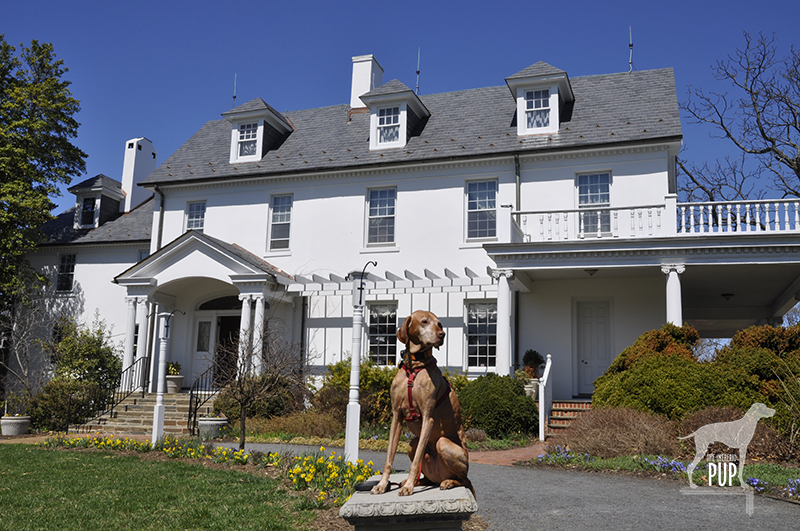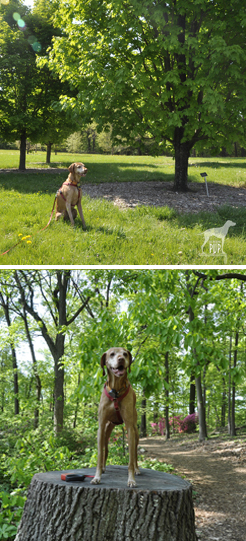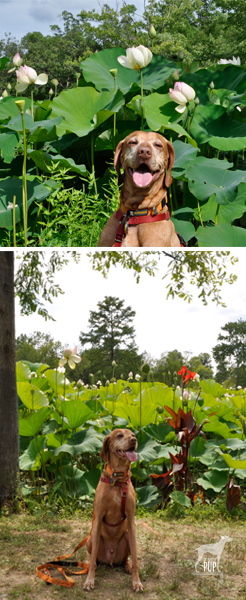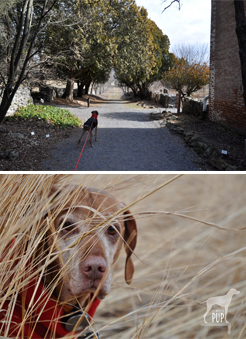
A public garden for every season! Top left: Spring’s peak azalea bloom at the National Arboretum in Washington, DC. Top right: Summertime Lily Fest at Kenilworth Aquatic Park & Gardens in Washington, DC. Bottom left: Autumn splendor in the Prairie at the Nichols Arboretum in Ann Arbor, Michigan. Bottom right: Winter at the Orland E. White State Arboretum of Virginia in Boyce.
“In the marvelous month of May when all the buds were bursting,
then in my heart did love arise . . . .” — Heinrich Heine

Tavish at River Farm, home to the American Horticultural Society and–you guessed it–some pretty spiffy gardens!
April showers bring May flowers, and what better time to head into the garden? If not your own, then how about one of the hundreds of botanical gardens and arboreta throughout the country? Truth be told, public gardens are there for you year-round providing a feast for the senses, a tonic for the soul . . . and a great place to go for a long walk with your intrepid pup!
To celebrate public gardens, we’re providing a stroll down a virtual garden path, starting with a horticultural grande dame and then continuing on to a public garden for each of the four seasons, “hand-picked” from Intrepid Pup’s travels over the past year.
Our first stop is River Farm in Alexandria, Virginia. The grounds were once among George Washington’s extensive land holdings, later given to his wife’s niece as a wedding present. Although the property has changed hands many times over the centuries, since 1973 the historic and picturesque 25 acres along the banks of the Potomac River have been the national headquarters for the American Horticultural Society. Leashed dogs are welcome, and during our visit to River Farm, Intrepid Pup Tavish strolled through the same gates as did 28 U.S. presidents! The circa 1819 northeast ceremonial gates to the White House were relocated here in the late 1930s after a renovation project. Tavish explored the meadow and gazed out over the river. He also sized up the largest Osage-orange tree in the United States; at nearly 200 years of age, the famous tree is believed to be a gift from Thomas Jefferson to George Washington. Finally, while we will neither confirm nor deny, it’s highly probable that Tavish photo-bombed some newlyweds’ formal pictures—the Estate House on the grounds is a popular wedding venue.
Onward to our seasonal picks . . .
Dogging the Details
These excursions register as a “1” on the Intrepid Pup wag-a-meter, because they’re as easy as a walk in the park!
Just get up and go.
U.S. National Arboretum: Tavish stands sentinel in the Grove of State Trees (top) with the closest one being Vermont’s sugar maple. (Below) Giving a “stump speech” along the azalea walk.
SPRING
38°54′30.65″ N, 76°58′18.95″ W
U. S. National Arboretum, Washington, DC
Free admission; leash requiredGo for the azaleas, but stay (and plan your return trips) for everything else. Intrepid Pup has previously chronicled the National Arboretum’s iconic azalea bloom—a riot of color which traditionally reaches peak in late April/early May—but spring is many-splendored here. There are bulbs and flowering cherries. Dogwoods and lilacs. Herbs and bonsai trees.
Intrepid Pup Tavish is particularly a sucker for the 30-acre expanse that is the National Grove of State Trees. Because of the District of Columbia’s relatively temperate climes, almost all the official state trees thrive here, even though they were acquired directly from their representative states. Seemingly no trip to the arboretum is complete for Tavish without rolling around in the grove’s long, cool grass.
On our most recent visit, a section of the arboretum was temporarily cordoned off but for the best of reasons: for the first time in nearly 70 years, a pair of bald eagles had built a nest! There were bird watchers galore craning to get a glimpse so instead we headed up onto the hillside paths that meander through the azalea collection. We took lots of photos, and Tavish’s aptitude for posing drew lots of bemused smiles and questions, not to mention people taking pictures of us taking pictures!
Like stepping into a real-life Monet canvas: Tavish at Kenilworth Park & Aquatic Gardens’ annual Lily Fest
SUMMER
38°54′45.50″N, 76°56′31.24″W
Kenilworth Park & Aquatic Gardens, Washington, DC
Free admission; leash requiredTell folks you’re heading into these sultry gardens in the middle of a humid Washington, DC summer, and people are bound to think you’re already suffering from heatstroke. But . . . the rewards are the magnificent lotus flowers and water lilies. Kenilworth is the only National Park Service site devoted to the cultivation of aquatic plants—you’ll want to read our earlier post about the site’s unique history.
The freshwater plants bloom in late June and July, and when they do, it’s like being immersed in a Claude Monet painting with sun-dappled greens and bursts of white and pale pink. But a word to the wise: go before the heat of the day, because as soon as the temperatures hit the high 80s/low 90s, the delicate blossoms shut until the next morning. Be sure to bring along plenty of water for you and your pup so you both don’t wilt!
We timed our visit with the park’s annual Lily Fest cultural event in mid July. As bands played, we wandered the boardwalks. The lotus flowers towered over us, and dragonflies zoomed by in their herky-jerky version of floral connect-the-dots. A pretty surreal way to enjoy this urban oasis!
(Top) At the Arb’s Washington Heights entrance with the Urban Environmental Education Center in the background. (Bottom) A warm autumn afternoon along the Huron River.
AUTUMN
42°16’50.07″N, 83°43’36.55″W
Nichols Arboretum, Ann Arbor, Michigan
Free admission; leash requiredAffectionately known as “the Arb,” Nichols Arboretum is managed by the University of Michigan, its undeniable main draw since 1927 being its world-famous peonies. When they peak in late May/early June, there can be as many as 10,000 flowers in 270 varieties—the largest collection in North America. Sadly, we missed this spectacle by about five months, but we discovered that the Arb is beautiful in October, too. We visited on a weekday afternoon when university classes were in session and didn’t have too much difficulty finding free parking near the Washington Heights entrance. Team Tavish had been on the road and visiting with relatives for a couple of days, so this stopover was a chance for Tavish to really stretch his legs and burn off some energy. We passed the dormant peony beds and a whimsical Faerie Garden, heading gently downhill. The trail entered woodland and then skirted the Huron River. Tavish dipped his paws in and was fixated on a large crayfish chilling out in the shallows. Reluctantly Tavish left the river’s edge only to be equally fascinated by the open Prairie section that followed. The tall grasses had turned golden with autumn, and it was hard to believe we were so close to a bustling college campus. We circled back through the shaded Hawthorn Valley, ultimately covering about three miles.
Tavish exploring the State Arboretum of Virginia.
WINTER
39° 3’51.72″N, 78° 3’51.67″W
Orland E. White State Arboretum of Virginia, Boyce, Virginia
Free admission; leash required within 200 yards of parking areas and/or any of the public buildingsThe University of Virginia manages this 172-acre arboretum as part of the larger, 712-acre Blandy Experimental Farm. Located in the northern Shenandoah Valley, the arboretum is only 60 miles west of the nation’s capital but feels a world away for as little as it resembles metro Washington’s urban sprawl. The gardens originated in 1927 but weren’t dubbed the State Arboretum until 1986.
Four walking loop trails originate from the main parking lot and range in length from 0.75 to 2 miles. Longer still is a 7.5-mile bridle trail that winds throughout Blandy. Unlike many public gardens, dogs are allowed off leash throughout most of the site, provided that they don’t disrupt wildlife or the plantings. Additional caveats are that your dog must be under immediate voice control and be put on a leash when within 200 yards of the parking areas or any of the public buildings. As a dog-friendly locale, pet waste stations are provided.
We visited on a sunny February afternoon just ahead of a stormy cold front. Nothing was in bloom, but the vast grounds still exuded a stark and vaguely haunting beauty. We encountered a few other hearty walkers and dogs as we made our way around. Birds scrabbled over winter berries, and evidence of deer was in abundance. In addition to manicured landscapes were test plots where various studies were underway, including research to create a more disease-resistant chestnut tree. The highlight for Tavish was the open landscape flanking the Wilkins Lane Loop Drive. The scrub grasses—bleached and brittle from winter—put Tavish on high alert, and he bounded in, picking up on scents of upland game that only his nose could.






 Think you know where Yonder was this
Think you know where Yonder was this 









 Just in time for Presidents’ Day is this week’s
Just in time for Presidents’ Day is this week’s  to U.S. president Gerald Ford from Ford’s daughter and the White House photographer.
to U.S. president Gerald Ford from Ford’s daughter and the White House photographer.
